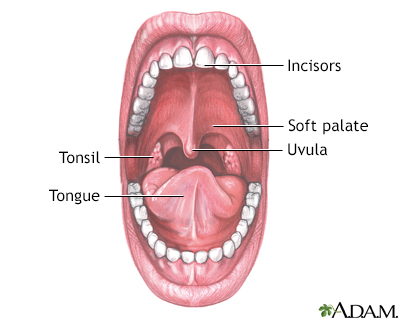Pregnancy SmartSiteTM
Cancer - mouth; Mouth cancer; Head and neck cancer - oral; Squamous cell cancer - mouth; Malignant neoplasm - oral; Oropharyngeal cancer - HPV; Carcinoma - mouth DefinitionOral cancer is cancer that starts in the mouth. CausesOral cancer most commonly involves the lips or the tongue. It may also occur on the:
Most oral cancers are a type called squamous cell carcinoma. These cancers tend to spread quickly. Smoking and other tobacco use are linked to most cases of oral cancer. Heavy alcohol use also increases the risk for oral cancer. Human papillomavirus (HPV) infection (the same virus that causes genital warts) account for a larger number of oral cancers than in the past. One type of HPV, type 16 or HPV-16, is much more commonly associated with almost all oral cancers. Other factors that may increase the risk for oral cancer include:
Some oral cancers begin as a white plaque (leukoplakia) or as a mouth ulcer. Men develop oral cancer twice as often as women do. It is more common in men older than 40. SymptomsOral cancer can appear as a lump or ulcer in the mouth that may be:
Other symptoms may include::
Exams and TestsYour health care provider or dentist will examine your mouth area. The exam may show:
A biopsy of the sore or ulcer will be done. This tissue will also be tested for HPV. CT, MRI, and PET scans may be done to determine if the cancer has spread. TreatmentSurgery to remove the tumor is recommended if the tumor is small enough. If the tumor has spread to more tissue or nearby lymph nodes, a larger surgery is done. The amount of tissue and the number of lymph nodes that are removed depend on how far the cancer has spread. Surgery may be used together with radiation therapy and chemotherapy for larger tumors. Other treatments may include:
Depending on what type of treatment you require, supportive treatments that may be needed include:
Support GroupsYou can ease the stress of illness by joining a cancer support group. Sharing with others who have common experiences and problems can help you not feel alone. Outlook (Prognosis)About one half of people with oral cancer will live more than 5 years after they are diagnosed and treated. If the cancer is found early, before it has spread to other tissues, the cure rate ranges from 59% to 94% depending on where the cancer is located. More than half of oral cancers have spread when the cancer is detected. Most have spread to the throat or neck. Cancers that test positive for HPV appear to respond better to treatment and may have a better outlook. Also, those who smoked for less than 10 years may do better. People who require larger doses of radiation along with chemotherapy are more likely to have more severe problems with swallowing. Oral cancers can recur if tobacco or alcohol use is not stopped. Possible ComplicationsComplications of oral cancer may include:
When to Contact a Medical ProfessionalOral cancer may be discovered when the dentist does a routine cleaning and examination. Contact your provider if you have a sore in your mouth or lip or a lump in the neck that does not go away within one month. Early diagnosis and treatment of oral cancer greatly increases the chance of survival. PreventionOral cancer may be prevented by:
The HPV vaccine recommended for children and young adults targets HPV sub-types most likely to cause oral cancers. They have been shown to prevent most oral HPV infections and 90% of cancers caused by HPV. ReferencesKerr AR, Miller CS, Rhodus NL, Stoopler ET, Treister NS. Cancer and oral care of patients with cancer. In: Kerr AR, Miller CS, Rhodus NL, Stoopler ET, Treister NS, eds. Little and Falace's Dental Management of the Medically Compromised Patient. 10th ed. Philadelphia, PA: Elsevier; 2024:chap 26. National Cancer Institute website. Oropharyngeal cancer treatment (adult) (PDQ) - health professional version. www.cancer.gov/types/head-and-neck/hp/adult/oropharyngeal-treatment-pdq#link/_528. Updated September 5, 2023. Accessed January 16, 2024. Rettig E, Fakhry C, Gourin CG. Human papillomavirus and the epidemiology of head and neck cancer. In: Flint PW, Haughey BH, Francis HW, et al, eds. Cummings Otolaryngology: Head and Neck Surgery. 7th ed. Philadelphia, PA: Elsevier; 2021:chap 74. Wein RO, Weber RS. Malignant neoplasms of the oral cavity. In: Flint PW, Haughey BH, Francis HW, et al, eds. Cummings Otolaryngology: Head and Neck Surgery. 7th ed. Philadelphia, PA: Elsevier; 2021:chap 91. | ||
| ||
Review Date: 12/31/2023 Reviewed By: Josef Shargorodsky, MD, MPH, Johns Hopkins University School of Medicine, Baltimore, MD. Also reviewed by David C. Dugdale, MD, Medical Director, Brenda Conaway, Editorial Director, and the A.D.A.M. Editorial team. View References The information provided herein should not be used during any medical emergency or for the diagnosis or treatment of any medical condition. A licensed medical professional should be consulted for diagnosis and treatment of any and all medical conditions. Links to other sites are provided for information only -- they do not constitute endorsements of those other sites. No warranty of any kind, either expressed or implied, is made as to the accuracy, reliability, timeliness, or correctness of any translations made by a third-party service of the information provided herein into any other language. © 1997- A.D.A.M., a business unit of Ebix, Inc. Any duplication or distribution of the information contained herein is strictly prohibited. | ||


 Throat anatomy
Throat anatomy Mouth anatomy
Mouth anatomy
